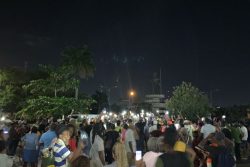The recent upheaval arising out of the displacement of several vendors from outside the Stabroek Market following the grenade explosion early last month raises once again the issue of how to treat seriously with urban street vending.
It is not as simple an issue as it might appear to be. Public discourse on street vending invariably addresses only half of the equation while ignoring the other. Those aspects that are usually mentioned whenever the issue arises has to do with congestion, garbage disposal, health considerations and the sharing of space between street vending and the established urban commercial pursuits. The other half of the equation which concerns the right of vendors to make a living and to support their families in an economy in which unemployment in the formal sector is high rarely enters the discourse. We tend to overlook too the significance of the choice that the vendors have made in a society in which it has become ridiculously easy to pursue other less desirable avenues for ‘making a living.’ At a time when crime, particularly violent crime, is clearly out of control, the decision by young, unemployed people to turn to vending as an option to criminal pursuits has to be applauded.
In the past several years, the municipal authorities in the city have sought to tackle the issue of street vending in a manner that has been ad hoc and mostly unfavourable to vendors. If regulations do not explicitly ban street vending, they hamper it by restricting vending locations, or prescribing modes of operation including hours of operation that are not designed to enable the vendors to maximize their earnings. Moreover, such arrangements as govern street vending leave the vendors permanently vulnerable to the kind of dismantling and dispersal operation that arose out of the Stabroek explosion.
Extant arrangements between the municipal authorities and some vendors include payments to the municipality for the privilege of trading even in cases where the vendors themselves are not legitimized. Other arrangements allow vendors to trade, illegally, for specific periods, including Christmas after which their right to trade in particular locations once again becomes an issue.
Urban vending and the problems associated with the practice are not unique to Guyana. Last Decem-ber, for example, protest erupted in Trinidad and Tobago after disgruntled street vendors objected to being omitted from a list of those entitled to a spot at the vendors’ facility. The Mayor of the particular jurisdiction became embroiled in a controversy associated with the pulling of lots for occupancy of the facility and some time had to be spent addressing the issue.
The authorities in Barbados have also had to face challenges associated with street vending on the island including an incident a few years ago in which vendors from Swan Street in Bridgetown protested their eviction by the police (on the grounds that government wanted to clean up the area) and their replacement with non-Barbadian vendors. The Bajan vendors made a fuss and were duly reinstated.
In Jamaica, too, urban planners have long been battling with what is often the chaos created by vendors on the streets of Kingston which, they say, could be lessened if market areas were designed to take account of pedestrians rather vehicular traffic.
The differences between Guyana and many other countries in the Caribbean in this regard are, first, that in other capitals in the region including Port of Spain, Bridgetown and Kingston, there are well-established vendors associations that represent the interests of vendors; and second, there is evidence in those other territories of efforts by the municipal authorities to tackle the issue of street vending in a structured manner including factoring vendors into urban planning considerations. Here in Guyana the approach has been to hop from one ad hoc arrangement to another.
Arguments for the legitimacy of street vending in other Caribbean territories are also linked to the desirability of incorporating the culture of vending into urban structures so that the practice comes to be seen as a legitimate part of the pattern of urban tapestry. In that context it becomes as much a socio-cultural phenomenon as an economic phenomenon. Where street vending exists in more developed countries and in other Caribbean territories, more attention is paid to pedestrian activities in the urban planning process. Here in Guyana, the voracious demand for motor vehicles within an urban space that is already small and cluttered means that urban planning is hard pressed to take account of pedestrian activities and, by extension, vending activities.
There is nothing wrong, for example, with allocating designated spots on some sidewalks to vendors in a manner that does not impede other pedestrian activity. It has been done elsewhere in the region. A case can also be made for zoning sections of the capital as pedestrian areas, perhaps once weekly, restricting vehicular traffic and parking in that designated area and allowing for organized vending.
Even with the constraint of limited urban space one feels that more could be done to address the issue of embracing street vending as a facet of our urban commercial culture. Experience has proven that there is simply no virtue in sticking to the existing on-off, on-off arrangements that simply do not address the full and effective legitimization of street vending.









